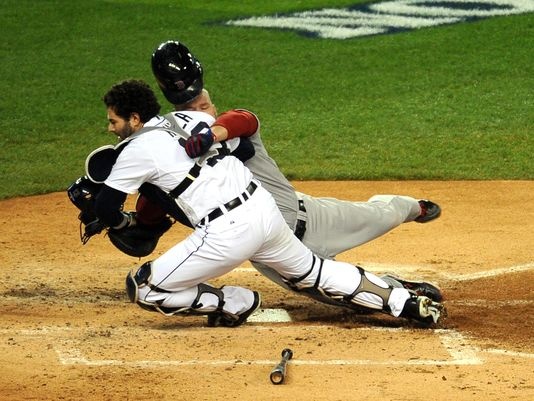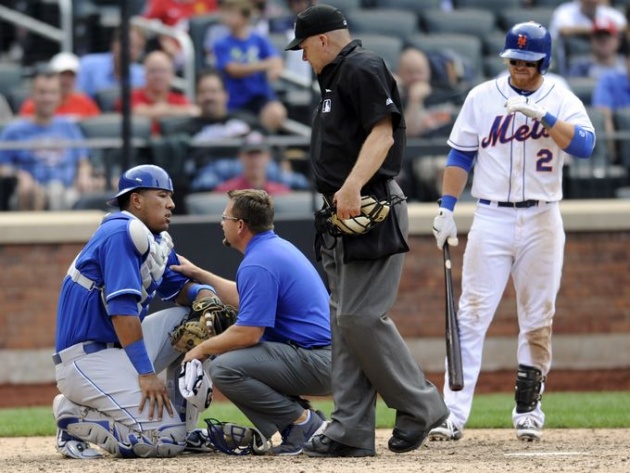
Red Sox's David Ross collides with Tigers catcher Alex Avila in Game 5 of the American League Championship Series.(Photo: Tim Fuller, USA TODAY Sports)
TAMPA -- Major League Baseball implemented an experimental, controversial rule Monday to protect catchers, prohibiting baserunners from initiating deliberate collisions at home plate in hopes of preventing concussions and injuries.
Tony Clark, executive director of the Major League Players Association, cautions that the rule will be on an experimental basis only for the 2014 season, particularly after hearing a mixed reaction from veteran catchers.
"I disagree with it,'' Boston Red Sox catcher A.J. Pierznyski told USA TODAY Sports over the weekend. "I understand why they're doing it, but next, they're going to tell us that you can't slide into the guy at second base.
"It's one of those things, as a big-league catcher, I signed up for it. You never want to see guys get hurt, and you never want to see guys go down because of it, but it's part of the game you signed up for.
"There are going to be plays at the plate, late in games, where you need to block the plate and try to keep that guy from scoring, saving save a run that ultimately gets your team into the playoffs.
"And not given that opportunity is unfair. I understand why the rule is made, but I wish there was a better way to go about it.''
The rule, 7.13, was borne in large part after San Francisco Giants All-Star catcher Buster Posey broke his leg in a violent home-plate collision with Marlins outfielder Scott Cousins.
"Our goal is to eliminate the vicious hits, for a baserunner to go and instead of targeting home plate, he's going to target the catcher, like in the Posey case,'' said Joe Torre, MLB's vice president of baseball operations, who has been briefing teams on the collision rule and the expanded use of replay.
The new guidelines still allow runners to initiate contact if the catcher has the ball and is blocking the plate. Runners don't have to slide, but those who do won't be found in violation of the rule.
"He can run into (the catcher), but he can't elbow him, shoulder him,'' Torre said, "and that's where the replay stuff is going to come in.''
The rule also prevents catchers from blocking home plate without possession of the ball. If the catcher impedes the baserunner without the ball, the runner will be automatically safe. And if the baserunner goes out of his way to deliberately initial contact with the catcher, he will be called out.
The home-plate collision will also be subject to instant replay review.
"It puts the umpires in a horrible spot,'' Pierznyski said. They not only have to decide whether the runner is safe or out, but did the catcher block the plate? He's going to have to make a million different decisions.
"I feel sorry for those guys. That's going to be one of the hardest things for those guys. They're going to be put in a really awkward spot.''
Clark understands the mixed feelings and debate with the new rule, addressing it with reporters Monday after meeting with the New York Yankees.
"There's a lot of questions,'' Clark said. "Everybody starts from the same position, how do we protect players? We start there, but when you consider how that is going to translate to play on the field, there are some things that often times that can make the water a little muddy.
"The concern was protecting players and trying to draw up something that not only made sense on paper, but always was going to make sense to the players playing on the field who are going to be processing information in a very short period of time. You're talking about a ball coming to home plate, a guy trying to score, and often times you're talking about the game on a the line.
"Now that it manifests itself according to a rule that going to potential change habits is a very delicate situation. If you're not careful, you're going to put both the runner and the catcher in a place where both can be injured. So obviously, that's not the focus.''
Major League Baseball announced that it will distribute training materials this spring, including the re-training of catchers and base runners with managers. There also will be a committee of players and managers to review developments during the season for possible changes in 2015.
The official new 7.13 rule will read:
1) A runner attempting to score may not deviate from his direct pathway to the plate in order to initiate contact with the catcher (or other player covering home plate). If, in the judgment of the Umpire, a runner attempting to score initiates contact with the catcher (or other player covering home plate) in such a manner, the Umpire shall declare the runner out (even if the player covering home plate loses possession of the ball). In such circumstances, the Umpire shall call the ball dead, and all other base runners shall return to the last base touched at the time of the collision.
The interpretation reads: The failure by the runner to make an effort to touch the plate, the runner's lowering of the shoulder, or the runner's pushing through with his hands, elbows or arms, would support a determination that the runner deviated from the pathway in order to initiate contact with the catcher in violation of Rule 7.13. If the runner slides into the plate in an appropriate manner, he shall not be adjudged to have violated Rule 7.13. A slide shall be deemed appropriate, in the case of a feet first slide, if the runner's buttocks and legs should hit the ground before contact with the catcher. In the case of a head first slide, a runner shall be deemed to have slid appropriately if his body should hit the ground before contact with the catcher.
1) Unless the catcher is in possession of the ball, the catcher cannot block the pathway of the runner as he is attempting to score. If, in the judgment of the Umpire, the catcher without possession of the ball blocks the pathway of the runner, the Umpire shall call or signal the runner safe. Notwithstanding the above, it shall not be considered a violation of this Rule 7.13 if the catcher blocks the pathway of the runner in order to field a throw, and the Umpire determines that the catcher could not have fielded the ball without blocking the pathway of the runner and that contact with the runner was unavoidable.
2) Unless the catcher is in possession of the ball, the catcher cannot block the pathway of the runner as he is attempting to score. If, in the judgment of the Umpire, the catcher without possession of the ball blocks the pathway of the runner, the Umpire shall call or signal the runner safe. Notwithstanding the above, it shall not be considered a violation of this Rule 7.13 if the catcher blocks the pathway of the runner in order to field a throw, and the Umpire determines that the catcher could not have fielded the ball without blocking the pathway of the runner and that contact with the runner was unavoidable.''
"The game for a lot of these guys has been played one way, one mindset, one focal point,'' Clark said, "and that doesn't change overnight. A lot of that that falls that comes into play with the rule itself that perhaps looking to change some habits. That's going to take some time for habits to change. You're going to put some guys into harm's way.
"If we need to, we can adjust going forward. Should we need to scrap, we can do so. If we need to continue to build out, we can do that as well.''

Source: USA TODAY
Annex News - Sport



